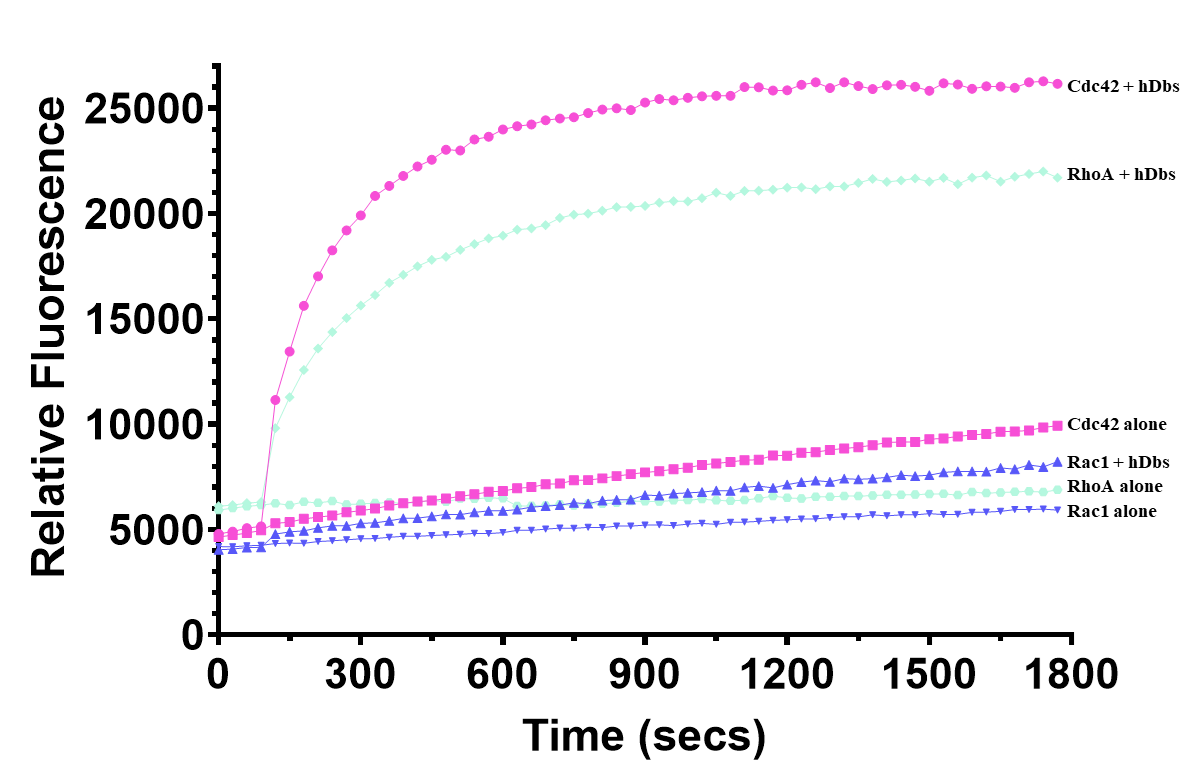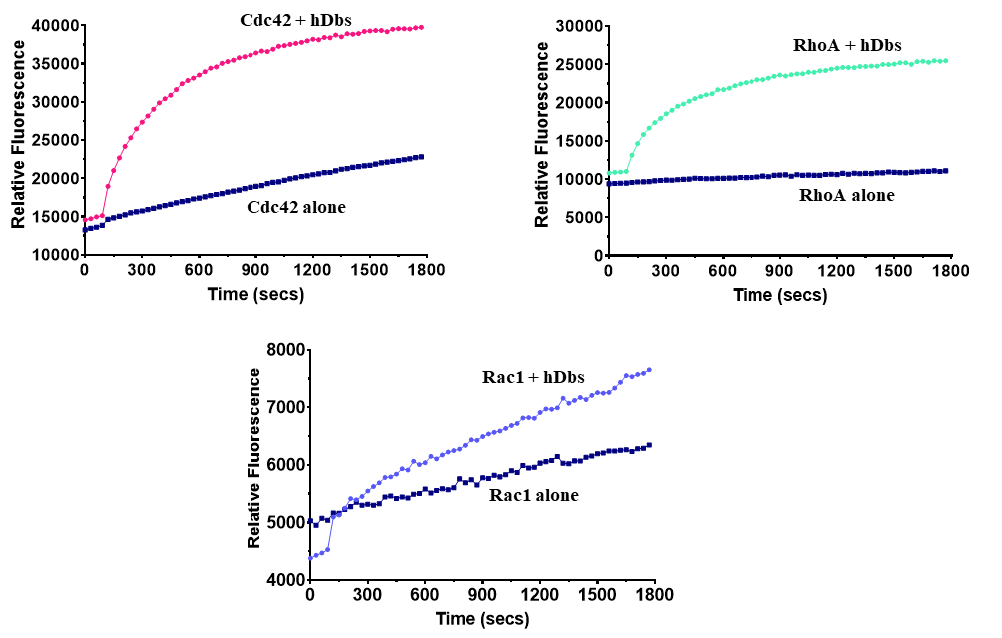Product Uses Include
- Determination of the activity and GTPase specificity of uncharacterized GEFs.
- Biochemical characterization of small GTPases and their associated GEFs.
- Examination of the regulation of GEF activity by different cofactors or protein domains.
- Screen the mutant protein of either GEFs or GTPases for activity and substrate specificity.
- Identification of GEF inhibitors in HTS (high throughput screen) format. Please inquire for significant discounts on large quantities of any reagents in this kit
Introduction
The Ras superfamily of small GTPases consist of more than 150 members, which based on their sequence homology, are divided into several subfamilies such as Rho, Ras, Ran, Rab, Arf and Rem/Rad families. This group of small GTPases serve as binary switches cycling between GDP-bound inactive and GTP-bound active states . The regulatory proteins for this switch include guanine nucleotide exchange factors (GEFs), GTPase activating proteins (GAPs) and guanine nucleotide dissociation inhibitors (GDIs). GEFs catalyze the exchange of GDP for GTP to generate the active state of small GTPases in response to extracellular signals. In order to facilitate the exchange, the GEFs must bind to the GDP-bound GTPases, destabilize the GDP-GTPase complex, and then stabilize a nucleotide-free reaction intermediate. Because of the high intracellular ratio of GTP to GDP, the released GDP is replaced with GTP, leading to release of GEFs from the complex and activation of the GTPase. Many GEF proteins have been identified as oncogenes and are involved in human diseases such as cancer. Interestingly, the expression of GEF protein is tissue- or cell-type specific, providing a therapeutic potential for cancer treatment. Recently developed fluorescence analogs of guanine nucleotides have greatly improved the technical ability to define the real-time exchange reaction of GEFs, including kinetic and thermodynamic properties, thereby eliminating the need for traditional radioactive labeling methods. This fluorescence-based assay takes advantage of the spectroscopic difference between bound and unbound fluorescent analogs to guanine nucleotides and resulting in the ability to monitor nucleotide exchange of small GTPases. Once bound to GTPases, the emission intensity of the fluorophore increases dramatically. Therefore, the enhancement of fluorescent intensity in the presence of small GTPases and GEFs will reflect the respective GEF activities of known or unknown proteins. Cytoskeleton Inc. has developed a N-MAR-GTP fluorophore-based Rho-GEF assay suitable for both 96-well and 384-well formats. This assay can be applied to multiple research purposes such as characterizing the GEFs and identifying GEF inhibitors in a high-throughput screen format. This kit contains human Cdc42, Rac1 and RhoA proteins and the GEF domain of Dbs as a positive control GEF for Cdc42 and RhoA. Dbs shows extremely low GEF activity for Rac1. Interestingly, it was reported that human Dbs can activate Rac1 in a FRET-based assay.
While the kit comes with Cdc42, Rac1 and RhoA proteins, it can also be used for any other Ras superfamily GTPase. See our G-protein product family web page for other GTPases available from Cytoskeleton.
For a kit to measure GAP activity, see Cat. # BK105
Kit contents
The kit contains enough materials for 60 assays in 96-well format or 300 assays in 384-well format. The following components are included:
- Exchange Buffer
- His-tagged Cdc42 protein (Cat. # CD01)
- His-tagged Rac1 protein(Cat. # RC01)
- His-tagged RhoA protein (Cat. # RH01)
- His-tagged hDbs protein (Cat. # GE01)
- 384-well black half area round bottom plate
- 96-well black half area flat bottom plate
- Detailed instructions and troubleshooting manual.
Equipment needed
- Fluorescence plate reader (96 or 384-well) capable of measuring fluorescence at ex: 360 nm, em: 440 nm
Example results
The exchange activity of Dbs on Cdc42, RhoA and Rac1 was measured in 96-well and 384-well format (Fig 1 & 2)
Figure 1. Cdc42, RhoA, and Rac1 exchange assay
Figure 2. Dbs exchange activity for Cdc42, RhoA and Rac1 in 96-well half area plate format. The data shown are the averages of three experiments.
References
- 1) Shielge, J. M., et al. Trend Cell Biol., 2000, 10, 147-54.2) Whitehead, I. P., et al. Biochim. Biophys. Acta, 1997, 1332, F1-23.3) Zheng, Y. Trend Biochem Sci.2002. 26, 724-32.4) Cheng, L., et al. Mol. Cell. Biol. 2002. 22, 6895-6905.5) Rossman, K. L., et al. Embo J. 2002. 21, 1315-1326.6) McEwen, D.P., et al. Anal. Biochem. 2001. 291, 109-117.7) Whitehead, I. P., et al. Mol. Cell. Biol. 1999. 19, 7759-7770.8) Itoh, R. E., et al. Mol. Cell. Biol. 2002. 22, 6582-6591.9) Manor, D. Methods Enzymol. 2000. 325, 139-149.
For product Datasheets and MSDSs please click on the PDF links below. For additional information, click on the FAQs tab above or contact our Technical Support department at tservice@cytoskeleton.com
Question 1: What is the best way to measure GEF activity from a cell lysate?
Answer 1: First, the GEF protein must be immunoprecipitated from the cell lysate with either an antibody to the protein or to a tag (His, GST, etc.) that has been conjugated to the protein of interest. After eluting your protein of interest from the beads, the protein’s GEF activity can be measured using Cytoskeleton’s RhoGEF Exchange Assay Biochem Kit (Cat. # BK100). Cytoskeleton Inc. has developed a mant fluorophore-based GEF assay designed for characterizing GEFs and identifying GEF inhibitors. This kit contains human Cdc42 (Cat. # CD01), Rac1 (Cat. # RC01) and RhoA (Cat. # RH01) proteins and the GEF domain of Dbs (Cat. # GE01) as a positive control GEF for Cdc42 and RhoA. The kit also comes with a 384-well and 96-well plate along with exchange buffer that contains the mant-GTP. Once bound to GTPases, the fluorophore emission intensity of mant-GTP increases approximately 1.1 to 2.0 fold depending on the protein. Therefore, the enhancement of fluorescent intensity in the presence of small GTPases and GEFs will reflect the respective GEF activities of known or unknown proteins. We recommend titrating the concentration of your GEF protein to optimize its activity. We suggest a titration range of 0.01-1 µM. A citation that used our GEF assay kit with an immunoprecipitated protein is Kakiashvili et al., 2009. GEF-H1 mediates tumor necrosis factor-alpha-induced Rho activation and myosin phosphorylation: role in the regulation of tubular paracellular permeability. J. Biol. Chem. 284, 11454-11466.
Question 2: I want to use the RhoGEF Exchange Assay kit with a 384 well plate. Is this possible?
Answer 2: Yes, Cytoskeleton’s mant fluorophore based GEF assay (Cat. # BK100) is suitable for a 384 well high-throughput screen format. Up to 130 reactions per GTPase can be achieved if a 384-well low volume black round bottom plate (Corning Cat# 3676) is used. This type of 384 well plate is strongly recommended due to the greater signal/noise ratio. Do not use clear plates since that will give you significant background noise. We provide a 384 well plate and a protocol for this HTS format in the manual that comes with the kit.
If you have any questions concerning this product, please contact our Technical Service department at tservice@cytoskeleton.com










